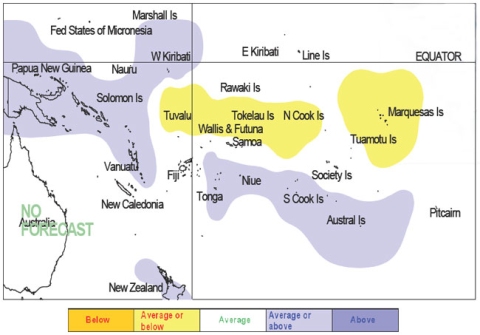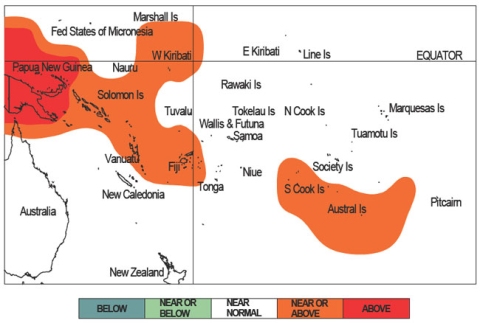Tropical rainfall and SST outlook: June to August 2009


During June – August 2009, a region of suppressed convection is likely in the southwest Pacific encompassing Tokelau, Tuvalu, the Northern Cook Islands, and the Marquesas, with below average rainfall expected for those areas. Near normal rainfall is forecast for Pitcairn Island and the Tuamotu Archipelago. Enhanced convection is likely around Papua New Guinea, the Solomon Islands, Western Kiribati, Vanuatu, Niue, Tonga, the Southern Cook Islands, and the Austral Islands with average or above average rainfall anticipated for the coming three month period. No clear precipitation guidance is offered for Fiji, New Caledonia, Eastern Kiribati, Samoa, the Society Islands, or Wallis & Futuna.
Prominent negative equatorial SST anomalies that existed in the region during the past months have eased. Global models indicate significant shifts to near-neutral SSTs during Austral winter, and a subsequent swing toward warm anomalies as early as Austral spring. Above average SSTs are expected for Papua New Guinea, while near or above average SSTs are forecast for Western Kiribati, the Solomon Islands, Vanuatu, Fiji, the Southern Cook Islands, and the Austral Islands. Near normal SSTs are forecast for Samoa, Tokelau, Tuvalu, the Northern Cook Islands, Wallis & Futuna, Tonga, the Marquesas, Eastern Kiribati, the Tuamotu Archipelago, Pitcairn Island, and the Society Islands. No clear SST guidance is provided for New Caledonia or Niue.
The confidence in the multi-model ensemble forecast skill for this seasonal rainfall outlook is moderately high for most Pacific Island countries. In the past, the average region-wide hit rate for rainfall forecasts issued in June is 60%, 1% lower than the long-term average for all months combined. The SST forecast confidence is moderate–to–high for this period.
|
|
NOTE: Rainfall estimates for Pacific Islands for the next three months are given in the table. The tercile probabilities (e.g., 20:30:50) are derived from the interpretation of several global climate models. They correspond to the odds of the observed rainfall being in the lowest (driest) one third of the rainfall distribution, the middle one third, or the highest (wettest) one third of the distribution. On the long-term average, rainfall is equally likely (33% chance) in any tercile.
